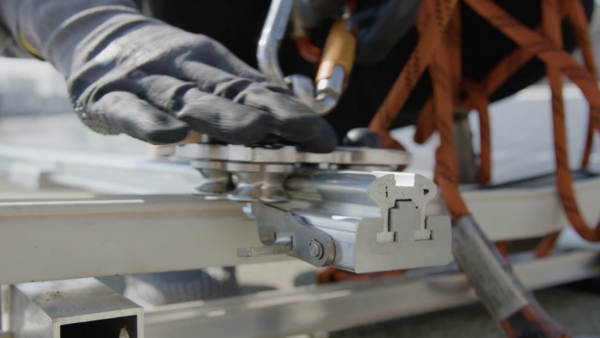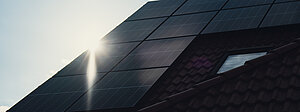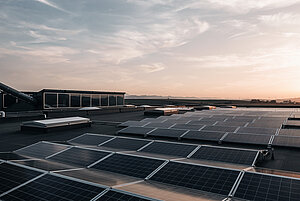This not only means that, as a solar system installer, you can perform the installation tasks in absolute safety, but it consequently also provides the operators of the solar power plants absolute certainty in terms of fall protection. And: In this way, the costs to the clients can be significantly reduced, because there is then no need for them to have retrospective work performed, and they thus also save themselves the related logistical effort. However, the most important thing is that through the installation of a professional, certified fall protection system for PV installations, all servicing and cleaning tasks on the PV system can be performed 100% safely at all times, and the employees enjoy complete protection against falls.
A further outcome is that the PV modules always provide their best performance, and can therefore produce the maximum solar power. And in the medium and long term the PV system operators notice this positive effect on their wallets.
The safety concept in detail for PV installations on a roof
It is essential that the professional, complete planning of fall protection systems for photovoltaic installations on a flat or pitched roof is performed holistically. This includes taking into account the latest technologies and standards which apply to fall protection. In addition, it is recommended that safety systems are planned to be user-friendly and easy to operate, because this in turn simplifies subsequent safety-relevant activities. Furthermore, the plan or safety concept must go into the actual circumstances of the location – for example, not just do angle of pitch and roof height play a fundamental role in the concept, but also can the characteristics of the building itself.
It is therefore very important to know whether the property is located in an area with high or low levels of snow, and accordingly which particular risks this could create. Last but not least, all documentation, inspections, and plans must be archived for the long term. However, first and foremost an exact assessment of the situation and an evaluation of the actual onsite situation must be carried out, so that a solid risk assessment can then be performed. This in turn forms the basis for determining the optimum fall protection measures for the respective project.
When generating the safety concept, the following need to be clarified:
- How frequently will the roof be accessed, and which tasks will be performed there?
- How are the access routes to and on the roof (roof entry and exits, or ladders and ascent aids)?
- How are tools and cleaning or other material transported onto the roof?
- How can the installation of the PV system and/or the fall protection system itself be performed safely?
- In an emergency, how feasible is rescue using the operator's own equipment?
- Which fall protection system is the best possible solution for the particular case? A basic distinction is made between individual and collective protection.
The optimum safety solution can be defined only after an exact analysis of the onsite situation. For this, the various sources of danger for the roof in question must be determined in advance, in order that the most appropriate fall protection system for the PV installation can then be planned. But under all circumstances this must comply with the latest state of the art and be certified.
General principles of planning
Particularly when planning fall protection systems for PV installations on a roof, it is important to examine very closely all relevant details of the respective installation case. Because potential errors could have fatal consequences. And therefore you should under all circumstances count on an expert partner and install only certified safety solutions. Planning the fall protection system requires consideration of a number of aspects. These include location and type of the anchorage devices. On the one hand, these must be positioned correctly, so that all areas of the roof and the PV system can be accessed safely.
In addition, the anchorage must be selected with care so that, in combination with the substructure of the PV system, this creates a safe load-bearing unit. Accessing the roof is a particularly sensitive phase – darkness, weather conditions, snow, wet, ice, and wind must be taken into account in order to ensure danger-free access to the anchorage devices. Often, the workers are often holding tools or cleaning materials in their hands, and this makes the process even more dangerous. The anchorage devices for access must therefore be planned very carefully, and they must be within easy reach.
Furthermore, the characteristics and load-bearing capacity of the substructure must be determined exactly, in order to prevent dangerous break-throughs when working on the roof. If in doubt, a structural engineer should be consulted. You will find further details about the general planning principles here:
The actuals dangers, combined with potential safety solutions
Even if the whole roof is treated as a danger area (especially for pitched roofs), here too there are different risk zones. As soon as an installer or a service and cleaning worker comes closer than 2 metres to a fall edge, a special danger area with increased fall risk comes into consideration. These areas (generally the roof edge) may be accessed only if the workers are protected by additional protective measures such as anchorage devices, lifeline or rail systems in the adjacent protected area, or by collective protection, such as guardrails. But falls are not the only causes of accidents when working on the PV system; roof components which are break-through hazards also represent a significant potential danger.
The 4 most significant potential dangers at a glance:
- The pitched roof as a danger area in itself
A pitched roof is defined as a roof with an inclination greater than 22° – acute skidding and slipping dangerexists here. People who move on pitched roofs in the course of servicing or cleaning tasks on PV systems can protect themselves against falls only by using individual protection solutions. Above all, the AIO lifeline system is a proven fall protection system for pitched roofs. Depending on the actual circumstances, the lifeline system is also combined with other safety solutions, such as SAFETY ROOF HOOKS or SINGLE ANCHOR POINTS/POSTS.
Recommendations in this area also include various SINGLE ANCHOR POINTS/POST SET ITEMS or, under certain conditions (above all on construction sites and building projects), the pre-installed KIT BOX SYSTEM.
- The fall edge
The fall edge is found at the perimeter of flat roofs. Especially here, there is an increased risk of falling! Tripping, slipping, or lack of attention in this fall risk area would mean a fall with disastrous consequences for the person positioned on the PV system and thus on the flat roof. Individual or collective protection solutions can provide a remedy here. The TAURUS rail safety system, the AIO lifeline system and SINGLE ANCHOR POINTS are suitable systems here. On a flat roof they can also be attached directly to the PV substructure.
As a collective protection solution, the BARRIER guardrail system (VARIO, ATTIKA, and FLEECE) is available. However, a skylight positioned on a roof can also create a fall edge. The same safety solutions can also be used to provide reliable fall protection. In particular, the BARRIER-LICHTKUPPEL system would be suitable as a safety solution.
- Fall-through
The danger of fall-through is mostly concealed, and cannot be recognised at first sight. It is therefore all the more important to record this danger area, in the same way as all other potential dangers mentioned, in a holistic and professional plan. On a PV installation on a roof, the danger of fall-through can occur above all with fibre-cement panels, translucent plastic panels, glass roofs, or skylights. The ideal safety solutions for successfully neutralising these danger areas are above all LIGHT SKYLIGHT PROTECTION, the LIGHT SKYLIGHT PROTECTION NET, BARRIER-LICHTKUPPEL and EAP-MOBI.
- The entrance or vertical ascent to the roof, and/or the descent.
The entrance to a flat or pitched roof, and thus to the PV installation, is one of the four most significant potential dangers. Entrance can be made via a roof hatch as well as a ladder. The TAURUS VERTIKAL and VERT LIFELINE SYSTEM were specially developed for safe vertical ascent and descent, and they ensure safe access to the roof.
Tip:
On a flat roof, our TAURUS-HORIZONTAL safety solutions as a guided system, and AIO LIFELINE SYSTEM PASSABLE as a horizontally guided system, and our SINGLE ANCHOR POINTS can be attached directly to the PV substructure. The benefits of this are of full use of the entire roof surface; no need for roof penetration, thanks to installation directly on the PV substructure; no shadows are cast, so no degradation of PV system performance. Find out more about this in our next blog post “Individual or collective protection? Which system is used when for PV installations on a roof?”

By loading this video, you accept Google's privacy policy.
Summary
In this application area, when it comes down to the legally prescribed protection of employees against falling, planning a PV system on a roof starts and ends with a seamless, solid safety concept. This because, in the potential danger situations named, a slight lack of attention can result in stumbling or slipping and end in a fall which frequently has disastrous consequences. Choosing the best possible fall protection system requires consideration of a number of aspects. You should therefore avail of a professional planning service. In this way, you cover all safety and legal aspects professionally and in a targeted manner, and you also save lives.
If you have further questions, simply contact us! We will be happy to support you in generating a professional safety concept for your PV system. So that you can sleep soundly when work needs to be done on your roof! If you too wish to enjoy the benefits of collaborating with a professional partner for fall protection systems, then you should download this guide immediately here.








![[Translate to Englisch:] [Translate to Englisch:]](https://www.innotech-safety.com/fileadmin/_processed_/1/a/csm_Mehrere_PV-Kunden_gleichzeitig_betreuen__kann_oft_zur_Riesenherausforderung_werden-header_c1a520d846.jpg)























